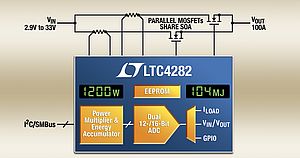Linear Technology, provider of battery stack monitoring ICs for electric and hybrid/electric vehicles, was demonstrating the industry’s first wireless automotive battery management system (BMS) concept car at electronica show in Munich. This wireless BMS concept car, developed by Linear’s design partner LION Smart, combines Linear’s highly accurate battery stack monitors with its SmartMesh® wireless mesh networking products in a BMW i3, replacing the traditional wired connections between the battery packs and the battery management system. This demonstration of a fully wireless BMS car represents a significant breakthrough that offers the potential for improved reliability, lower cost and weight, and reduced wiring complexity for large multicell battery stacks for electric and hybrid/electric vehicles.
Automakers are challenged to ensure the driving public that electric and hybrid/electric vehicles are both safe and reliable. The road-proven high voltage battery stack monitors deliver industry leading accuracy and reliability, enabling battery management systems that maximize battery pack performance and longevity. The LTC6811 is a complete battery measuring device for hybrid/electric vehicles that can measure up to 12 series-connected battery cell voltages with better than 0.04% accuracy. Combining the LTC6811 with Linear’s SmartMesh wireless mesh networking system addresses the persistent reliability issues associated with automotive wiring harnesses and connectors.
Field-proven in industrial Internet of Things applications, SmartMesh embedded wireless networks deliver >99.999% reliable connectivity in harsh environments by employing path and frequency diversity. In addition to improving reliability by creating multiple points of redundant connectivity, the wireless mesh network enables additional BMS capability. Wireless connectivity enables more flexible placement of battery modules, and makes possible the installation of sensors in locations previously unsuitable for a wiring harness. Wireless sensors integrated into the SmartMesh network, such as current and temperature monitors, offer the potential for synchronizing these measurements with cell voltages.



















